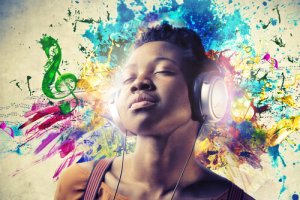Synesthesia: I Hear Colors and See Sounds

Synesthesia is a phenomenon that consists of experiencing, through the perception of a visual, tactile or auditory stimulus, a perceptive sensation that accompanies it. For example, one of the most common forms of synesthesia is to associate numbers, days of the week or months with a certain color. The person perceives them accompanied by a color which is always the same for each number or day.
Not many people experience this, but it is more common than we think. In fact, there are many people who do not know that their way of perceiving certain stimuli is different from the rest until they talk to someone and they realize that it is not “normal”.
This phenomenon is not experienced as unpleasant. Even the synesthetics cannot imagine the world without perceiving it the way they do. To them it would seem sad. So, we are not talking about a pathology, but rather a different and richer way of perceiving the world.
Different forms of synesthesia
There are many different forms of synesthesia. For example, there are people who, while listening to music perceive colors, although it is not a hallucination. It is not that they see colors and believe that they are part of reality, but instead when they listen to a piece of music, they are flooded by a stream of colors; each color being associated with a particular musical note.

A scientist, Jamie Ward, says that synestheticians experience the world in an extraordinary way and they have an extra sense of the stimuli that surround them. Words can evoke flavors, each number a certain color, pain can also be accompanied by a taste or a color, the touch of different surfaces, evoke a feeling… Thus, there are different ways of experiencing it.
Synesthesia and art
Perceiving their surroundings in such a rich way can encourage creativity. This can be very beneficial for those who dedicate themselves to art, since they can express through their works how the world presents itself to them.
A New York artist, Carol Steen, uses this condition to inspire her creations. This woman states that she can observe the color, taste and smell of pain. As a form of inspiration, she uses acupuncture to awaken these sensations and translate them into her works of art.

There is evidence of famous synesthetics such as the writer Vladimir Nabokov, who claimed that for him the combination of the letters “NZSPYGV” formed the rainbow. Also the physicist and Nobel prize-winner, Richard Feynman, and the philosopher, Ludwig Wittgenstein.
Is it hereditary?
Nowadays we know that synesthesia has a biological and genetic component, although the genes involved have not yet been accurately identified. Parents and children can inherit synesthesia, but the feelings do not have to be the same. The condition is inherited, but not the way it is experienced.
So much so that between twins it has been found that their experiences are not the same and even that one of the siblings can be synesthetic while the other is not. It can also happen that parents do not experience it, even if they are carriers of the gene and their child does express it.

Synesthetic children usually discover that they are this way in adolescence: when talking about a sound or a number they realize that all of us do not see it the way they do. For example, according to Ward, a child described the sounds through the colors, saying that the croaking of the frogs was usually brown, but that day it sounded blue, referring to the fact that the sound that day was sharper.
Synesthesia in the brain
There is an area in our brain that is responsible for the perception of colors: the V4. Julia Nunn, in an experiment performed with 12 people, observed that this part of the cerebral cortex was activated when the synesthesic subjects listened to a speech with their eyes closed, demonstrating that the perception of a stimulus (sound) automatically evoked the other (color).
In addition, the evocation of one sensation through another is almost instantaneous and always experienced in the same way. Some see it on paper in which they read the number or word, although they are aware that the sheet is blank. Others say that they see it as a kind of “inner screen” or that they see it as if floating.
By way of summary, it can be said that synesthesia is:
- Stable in time, perceiving the same sensations with each stimulus (always the same color for a specific number).
- Familiar, can be inherited.
- Specific, it always appears with the same stimuli.
- It happens quickly. Right after reading the word, listening to a song, touching a surface or seeing a number the accompanying feeling automatically apprears.
Other forms of synesthesia
This phenomenon occurs in people who perceive the environment in a special way from birth which is probably due to the inheritance of the genes involved. But it is not the only way to experience it. You can also experience a similar experience through the consumption of LSD.
It can be expressed even after blindness. People who are blind can, through hearing, experience visual images mentally. In this way, synesthesia is a phenomenon that still arouses the curiosity of many scientists and raises many questions about the way in which we perceive the world.
Prosopagnosia: The Distress That Brad Pitt Aches From
Prosopagnosia is a neurological disorder that affects Brad Pitt himself. Something that he has recently confessed and that has left us with the … See more »
Synesthesia is a phenomenon that consists of experiencing, through the perception of a visual, tactile or auditory stimulus, a perceptive sensation that accompanies it. For example, one of the most common forms of synesthesia is to associate numbers, days of the week or months with a certain color. The person perceives them accompanied by a color which is always the same for each number or day.
Not many people experience this, but it is more common than we think. In fact, there are many people who do not know that their way of perceiving certain stimuli is different from the rest until they talk to someone and they realize that it is not “normal”.
This phenomenon is not experienced as unpleasant. Even the synesthetics cannot imagine the world without perceiving it the way they do. To them it would seem sad. So, we are not talking about a pathology, but rather a different and richer way of perceiving the world.
Different forms of synesthesia
There are many different forms of synesthesia. For example, there are people who, while listening to music perceive colors, although it is not a hallucination. It is not that they see colors and believe that they are part of reality, but instead when they listen to a piece of music, they are flooded by a stream of colors; each color being associated with a particular musical note.

A scientist, Jamie Ward, says that synestheticians experience the world in an extraordinary way and they have an extra sense of the stimuli that surround them. Words can evoke flavors, each number a certain color, pain can also be accompanied by a taste or a color, the touch of different surfaces, evoke a feeling… Thus, there are different ways of experiencing it.
Synesthesia and art
Perceiving their surroundings in such a rich way can encourage creativity. This can be very beneficial for those who dedicate themselves to art, since they can express through their works how the world presents itself to them.
A New York artist, Carol Steen, uses this condition to inspire her creations. This woman states that she can observe the color, taste and smell of pain. As a form of inspiration, she uses acupuncture to awaken these sensations and translate them into her works of art.

There is evidence of famous synesthetics such as the writer Vladimir Nabokov, who claimed that for him the combination of the letters “NZSPYGV” formed the rainbow. Also the physicist and Nobel prize-winner, Richard Feynman, and the philosopher, Ludwig Wittgenstein.
Is it hereditary?
Nowadays we know that synesthesia has a biological and genetic component, although the genes involved have not yet been accurately identified. Parents and children can inherit synesthesia, but the feelings do not have to be the same. The condition is inherited, but not the way it is experienced.
So much so that between twins it has been found that their experiences are not the same and even that one of the siblings can be synesthetic while the other is not. It can also happen that parents do not experience it, even if they are carriers of the gene and their child does express it.

Synesthetic children usually discover that they are this way in adolescence: when talking about a sound or a number they realize that all of us do not see it the way they do. For example, according to Ward, a child described the sounds through the colors, saying that the croaking of the frogs was usually brown, but that day it sounded blue, referring to the fact that the sound that day was sharper.
Synesthesia in the brain
There is an area in our brain that is responsible for the perception of colors: the V4. Julia Nunn, in an experiment performed with 12 people, observed that this part of the cerebral cortex was activated when the synesthesic subjects listened to a speech with their eyes closed, demonstrating that the perception of a stimulus (sound) automatically evoked the other (color).
In addition, the evocation of one sensation through another is almost instantaneous and always experienced in the same way. Some see it on paper in which they read the number or word, although they are aware that the sheet is blank. Others say that they see it as a kind of “inner screen” or that they see it as if floating.
By way of summary, it can be said that synesthesia is:
- Stable in time, perceiving the same sensations with each stimulus (always the same color for a specific number).
- Familiar, can be inherited.
- Specific, it always appears with the same stimuli.
- It happens quickly. Right after reading the word, listening to a song, touching a surface or seeing a number the accompanying feeling automatically apprears.
Other forms of synesthesia
This phenomenon occurs in people who perceive the environment in a special way from birth which is probably due to the inheritance of the genes involved. But it is not the only way to experience it. You can also experience a similar experience through the consumption of LSD.
It can be expressed even after blindness. People who are blind can, through hearing, experience visual images mentally. In this way, synesthesia is a phenomenon that still arouses the curiosity of many scientists and raises many questions about the way in which we perceive the world.
Prosopagnosia: The Distress That Brad Pitt Aches From
Prosopagnosia is a neurological disorder that affects Brad Pitt himself. Something that he has recently confessed and that has left us with the … See more »
This text is provided for informational purposes only and does not replace consultation with a professional. If in doubt, consult your specialist.







